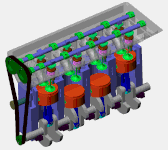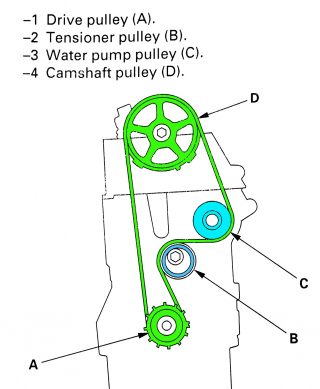
An animation showing a typical 4-cylinder engine. If you click to see the larger version, you’ll see the timing belt on the left side of the engine which synchronizes the crankshaft and camshafts.
 Four-cycle internal combustion engines use a camshaft to open and close the intake and exhaust valves. This shaft has an egg-shaped cam for each valve that pushes open the intake and exhaust valves in the proper sequence.
Four-cycle internal combustion engines use a camshaft to open and close the intake and exhaust valves. This shaft has an egg-shaped cam for each valve that pushes open the intake and exhaust valves in the proper sequence.
The camshaft is timed or synchronized with the crankshaft (what the pistons are attached to). In completing the four cycles there are two revolutions of the crankshaft for every revolution of the camshaft. No matter how fast or slow the engine goes, this ratio stays the same. The timing belt governs that ratio. It has rounded “teeth” that engage with sprockets on both the crankshaft and the camshaft.
Just like every other rubber component in your car, the timing belt will begin to break down over time. If it breaks, the pistons and valves will lose synchronization and catastrophic damage can result when they collide. Replacing the timing belt is not especially difficult, although there is usually quite a bit of disassembly to gain access to it. Here at Motor Works, we suggest replacing the outer drive belts and water pump at the same time as the timing belt because the water pump is driven by the timing belt and the outer belts must be removed anyway. It’s in your best interest to replace these items together as it represents the best use of your repair dollar. Since this function is critical to the life and operation of the engine, we strongly recommend using only original parts.

